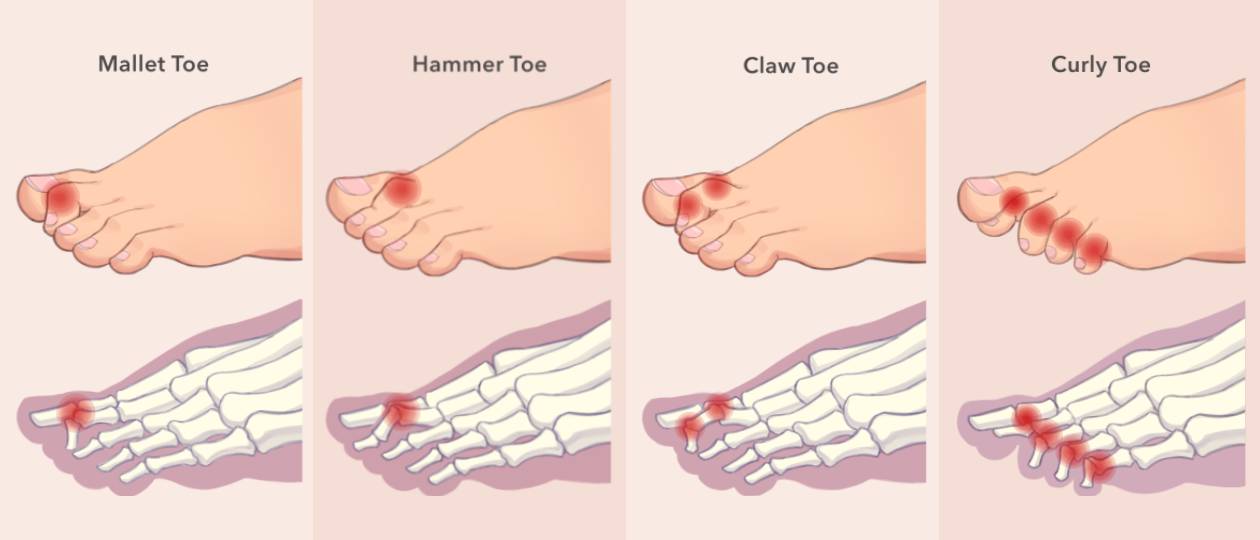Digiti Quinti Varus, or curly toe syndrome, is a condition that involves the curling of the toe bones in the foot. It most commonly presents in the 3rd, 4th or, 5th toe and often affects both feet.
Curly toe syndrome can be congenital, meaning from birth, or acquired and causes the toe to either cross over or under the neighbouring toe, or remain in a hook-like position. As your child begins walking, this condition can become more noticeable and progress from a flexible deformity to a more rigid one.
Symptoms Of Curly Toe
Some children may experience symptoms early on, such as:
- Flattened, thickened, or split toenails
- Painful corns or blisters from pressure
- A limitation in footwear choices
- Pain or discomfort during or after physical activities
- Frequent falling or tripping
- Gait imbalances
Although many children do not experience any symptoms other than the physical deformity of the toe(s), the presence of a curly toe may lead to long-term foot problems that will make walking difficult.
Curly toes may also be mistaken for other common forms of crooked toes such as:

- Hammer toe – Any toe with an abnormal bend at the middle joint, resembling a hammer. They commonly occur in the 2nd or 3rd toe of one or both feet.
- Mallet toe – Similar to hammer toes, mallet toes bend abnormally, but at the 1st joint of the toe closest to the nail.
- Claw toe – This involves the bending of the toes at both the 1st and 2nd joint. These can often lead to the development of painful corns and calluses.
- Overlapping toe – Any toe that overlaps over the adjacent toe in one or both feet. This affects the little toe in particular.
Causes of Curly Toe Syndrome
This toe deformity can be congenital and a hereditary trait in some cases. It is often caused by the contracture or shortening of the muscles within the foot, specifically the flexor digitorum longus and brevis muscles. These muscles control the movement of our toes and any imbalance in them can result in a curly toe deformity.
The shortening of these muscles can also be caused by the gripping of the toes on the floor, or poor footwear choices such as slippers and ill-fitting shoes. As the toes grip down to stabilise the foot, the small joints of the toe come under excess strain and can become deformed. If patients continue to wear ill-fitting or tight-fitting footwear, the excess pressure on the toes may lead to the development of corns, calluses, bursae, or blisters. This may even affect the integrity of the nail, leading to a nail deformity or an increased risk for fungal infections.
Curly toes are generally asymptomatic but may cause long-term problems such as a permanent bend in the toe, joint rigidity, and a shortening of the toe length. This may make movement difficult and require patients to wear specific shoes with wider and deeper toe boxes just to accommodate their foot type and curly toes.
How Is Curly Toe Managed?
Curly toes in children can be managed with conservative methods such as using customised insoles or paediatric ankle foot orthotics to achieve proper toe realignment. Coupled with the appropriate footwear, this can help to stabilise and support the child’s foot as they grow, reducing the risk of developing rigid and often painful toe deformities such as bunions.
Adults with curly toes often neglect podiatric care for the underlying conditions and focus on the secondary symptoms, such as bursae, pain, fungal infections, nail trauma, and tailor’s bunions. While these secondary symptoms can be resolved with a wide variety of in-clinic remedies, it is important to resolve curly toe as a root cause in order to prevent the occurrence of these secondary symptoms.
Frequently Asked Questions
Toe pain can arise from many causes such as, injuries, infectious diseases, or as a by-product of other disorders that affect the body.
Toe pain that presents at the top of the toe joints is often caused by biomechanical issues or muscle imbalance. Other forms of toe pain, such as those caused by underlying disorders or conditions, run the risk of becoming progressively worse. A professional diagnosis and podiatric intervention must be sought out to avoid complications.
Appropriate footwear such as shoes with a wide and deep toe box can reduce excess pressure at the affected toe joints.
See a podiatrist promptly for solutions such as a pair of customised insoles. Insoles can help prevent the deformity from worsening and offload weight from the affected areas. Your child’s foot structure is still malleable, and with early intervention it can prevent the progression and permanence of toe deformities.
Acquired curly toes can be prevented in your child by reducing the use of unsupportive footwear such as slippers. Regular stretching exercises can also reduce tightening in the toe muscles.
A pair of wide shoes with a deep square-shaped toe box can accommodate for toe deformities (curly toes/hammer toes/claw toes/mallet toes).
It depends on the type of activities and footwear your child will be exposed to. Curly toes will only affect your child’s activity level if they are required to wear tight footwear such as soccer boots or ballet shoes which can compress and irritate the deformity, making it uncomfortable to move.




